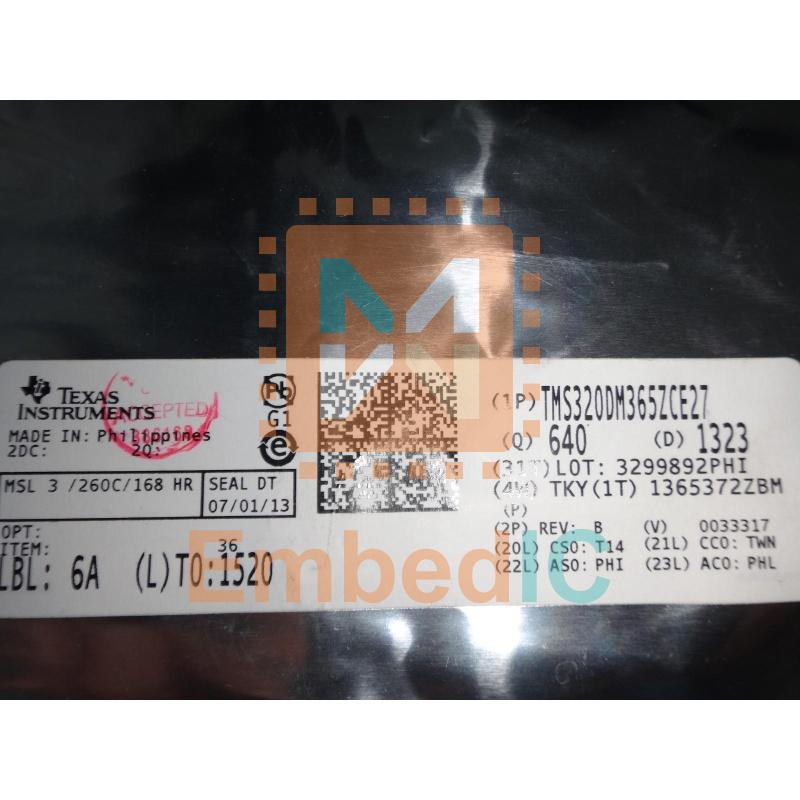IC DIGITAL MEDIA SOC 338NFBGA
 PCB Symbol, Footprint
PCB Symbol, Footprint
 Send Inquiry
Send Inquiry
 Download Datasheet
Download Datasheet
 SUPPLIERS WHOLESALE PRICE TRENDS
SUPPLIERS WHOLESALE PRICE TRENDSPrice comparison from authorized distributors
 TMS320DM365ZCE27 Competitive Prices
TMS320DM365ZCE27 Competitive Prices
EmbedIC has the unique source of supply. We can offer TMS320DM365ZCE27 more competitive price for our customers. You can enjoy our best service by purchasing Texas Instruments TMS320DM365ZCE27, Please feel free to contact for the best price of TMS320DM365ZCE27 SOC. Click To Get Quotation
Developers can now deliver pixel-perfect images at up to 720p H.264 at 30fps in their digital video designs without concerns of video format support, constrained network bandwidth, limited system storage capacity or cost with the new TMS320DM365 digital media processor based on DaVinci technology from Texas Instruments Incorporated (TI). With multi-format HD video, the DM365 also features a suite of peripherals saving developers on system costs.
This ARM9-based DM365 device offers speeds up to 300 MHz and supports production-qualified H.264, MPEG-4, MPEG-2, MJPEG and VC1/WMV9 codecs providing customers with the flexibility to select the right video codec for their application. These codecs are driven from video accelerators offloading compression needs from the ARM core so that developers can utilize the most performance from the ARM for their application. Video surveillance designers achieve greater compression efficiency providing more storage without straining the network bandwidth. Developers of media playback and camera-driven applications, such as video doorbells, digital signage, digital video recorders, portable media players and more can ensure interoperability as well as product scalability by taking advantage of the full suite of codecs supported on the DM365.
Along with multi-format HD video, the DM365 enables seamless interface to most additional external devices required for video applications. The image sensor interface is flexible enough to support CCD, CMOS, and various other interfaces such as BT.656, BT1120. The DM365 also offers a high level of integration with HD display support including, 3 built-in 10-bit HD Analog Video Digital to Analog Converters (DACs), DDR2/mDDR, Ethernet MAC, USB 2.0, integrated audio, Host Port Interface (HPI), Analog to Digital Converter, and many more features saving developers on overall system costs as well as real estate on their circuit boards allowing for a slimmer, sleeker design.
Clock Rate 270MHz
Operating Temperature 0℃ ~ 85℃ (TC)
Type Digital Media System-on-Chip (DMSoC)
Non-Volatile Memory ROM (16 kB)
Package / Case 338-LFBGA
Voltage - Core 1.20V
Voltage - I/O 1.8V, 3.3V
Mounting Type Surface Mount
Interface EBI/EMI, Ethernet, I2C, McBSP, SPI, UART, USB
Supplier Device Package 338-NFBGA (13x13)
On-Chip RAM 56kB

Manufacturer: Cypress
IC CAPSENCE 16K FLASH 48QFN
Product Categories: 8bit MCU
Lifecycle:
RoHS:
Manufacturer: Intel
IC SOC CORTEX-A9 1.5GHZ 672FBGA
Product Categories: SOC
Lifecycle:
RoHS:
Manufacturer: NXP
IC MCU 32BIT 256KB FLASH 144BGA
Product Categories: 32bit MCU
Lifecycle:
RoHS:
Manufacturer: NXP
IC MCU 32BIT 512KB FLASH 121BGA
Product Categories: 32bit MCU
Lifecycle:
RoHS:
Manufacturer: Cypress
IC MCU 32BIT 160KB FLASH 64LQFP
Product Categories: 32bit MCU
Lifecycle:
RoHS:
Manufacturer: Intel
IC SOC CORTEX-A9 1.5GHZ 672FBGA
Product Categories: SOC
Lifecycle:
RoHS:
Manufacturer: Cypress
IC DUAL CORE MCU 32B 512K 116BGA
Product Categories: 16bit MCU
Lifecycle:
RoHS:
Looking forward to your comment
Comment
 Popular Searches
Popular Searches8 Bit MCU, Flash, PIC16 Family PIC16F7XX Series Microcontrollers, 20 MHz, 7 KB, ...
EEPROM 2K 256 X 8 2.5V SERIAL EE IND
System-On-Modules - SOM RCM2200
32-bit Arm Cortex-A53 vision processor with ISP, powerful 3D GPU, dual APEX-2 v...
IC MCU 8BIT 60KB FLASH 44QFP
DSP 20MHZ 44QFP
1
2
3
4
5
6